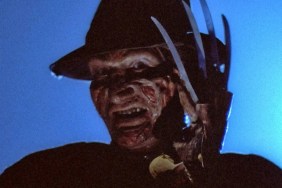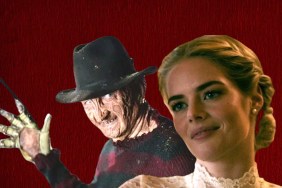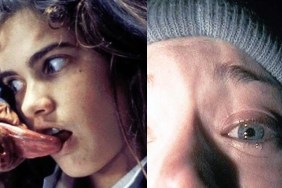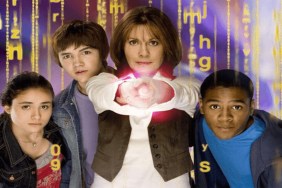Dennis Quaid, political assassination and snake men!

No one trick or treats on the last day of school, no one carves jack o’ lanterns on July 4th, or goes on haunted hayrides in August.
When it comes to beloved macabre traditions, the fall is the season that gets all the attention. Thanks to the celebration of Halloween, the autumn months have always been indelibly associated with all things frightful. Summer, on the other hand, is ostensibly all that horror isn’t about – a golden time of warm weather, trips to the beach, fireworks, road trips and family picnics.
For those movie buffs that prefer the inside of their neighborhood cinemas (or, for some, the nighttime chill of drive-in theaters) to the blistering heat, however, the summer is the real witching season. Some believe that horror vacations in summer, waiting for fall to arrive, but box office history tells a different story.
Starting in 1975 when Jaws invented the modern blockbuster by teaching a generation to be afraid of the ocean, summer has been the best time of year to be scared. The fall can keep Halloween. It can keep the costumes, the candy, the Great Pumpkin, all of it – because summer has always had the better movies.

With its brisk, breezy tone, appealing cast, beguiling special effects, and deft mix of genre elements, movies didn’t come much more entertaining in the ’80s (or since then, for that matter) than Dreamscape. This is a movie that literally has it all. As directed by Joseph Ruben (who co-wrote the screenplay with Chuck Russell, based on a story by David Loughery), it’s a speculative sci-fi mind-bender, a jump out of your chair horror movie (with some not-so-shabby PG-13 gore), a light romance, a political thriller, and an action film to boot. It’s Dreamscape, man!
Dennis Quaid plays Alex Gardner, a roguish type who makes a tidy, if slightly crooked, living using his psychic abilities not to change the world but to make a killing at the racetrack. One day, he’s hauled against his will into a government-funded project headed by his old mentor Dr. Paul Novotny (Max Von Sydow). Novotny’s project involves the new technology of dream-linking and with his already formidable mental abilities, all it takes is a room full of sci-fi hardware to get Alex past that subconscious threshold.
Other talented psychics have been dream-linking their asses off prior to Alex’s participation and for both good and bad, their experiences give Alex an idea of what he may be in store for. One psychic suffers a mental breakdown after going into a child’s nightmare and has to be carted off in a catatonic state. On the other hand, an encouraging success story comes from the project’s resident hot shot, the “Neil Armstrong of dream-linking,” Tommy Ray Glatman (David Patrick Kelly of 1979’s The Warriors, adding yet another memorable villain role to his résumé).

Before long, it’s clear that when it comes to Tommy, Alex is going to have a lot more to contend with than just a surly attitude. It turns out that Tommy is the pet psycho of Bob Blair (Christopher Plummer), a high-ranking government agent who is busy hijacking Novotny’s work for his own political schemes. Blair believes the President (Eddie Albert) is becoming too influenced by recurring nightmares of a nuclear holocaust and will weaken the US’s military might because of it, signing a peace agreement with the Russians. A eerily prescident precursor of such right wing demigouges as Donald Rumsfeld and Dick Cheney, Blair will hear none of that peace talk and while he brings the President to Novotny’s clinic on the pretense of curing his nightmares, what he really intends is for Tommy to get into the President’s dreams and assassinate him (in Dreamscape, as in A Nightmare on Elm Street, the old wives tale about dying in your dreams and dying at the same time in real life proves to be true). It’s up to Alex to prevent this political coup d’état and in the end Dreamscape comes down to a psychic battle to the death between Alex and Tommy (who busts out some green-glowing neon numchucks) inside the President’s nightmare of a nuclear-wasted Washington D.C. with the fate of the free world at stake.
Taking its cues from the previous year’s adaptation of Stephen King’s The Dead Zone (1983), the screenplay for Dreamscape shares that film’s episodic structure as Alex spends the bulk of Dreamscape solving the problems of various characters, as though we’re watching Dreamscape: The Series. Whereas in The Dead Zone, John Smith tells a nurse her house is on fire, catches a serial killer, and prevents a student from falling through the ice of a frozen pond; in Dreamscape, Alex helps a steel worker with their fear of heights, helps a middle-aged husband who thinks his wife is cheating on him, and helps a young boy defeat the snake-like creature of his nightmares. In both films, these smaller stories serve as warm-up exercises towards a much bigger challenge for their protagonists as an apocalyptic political threat (in The Dead Zone, it’s the presidential aspirations of Greg Stillson, in Dreamscape the hawk-like machinations of Bob Blair) is coming to a head and only Johnny and Alex’s respective powers will be able to avert it.

A few months after Dreamscape‘s summer release, Wes Craven’s original A Nightmare on Elm Street arrived in theaters (Craven’s script had made the rounds in Hollywood for years prior to being made and it’s possible that Dreamscape took some inspiration from Craven’s long-languishing project – just check out the Freddy-esque finger knives that Tommy sports in one scene!) but while Craven showed an uncanny fidelity towards recreating the true ‘rubber reality’ of dreams, Dreamscape‘s more bourgeois approach was fitting for the kind of high-tech but non-edgy Saturday matinee-style cliffhanger entertainment that it aimed to be (even its poster was drawn by artist Drew Struzan, famed for his posters for Raiders of the Lost Ark and the Star Wars series). With Elm Street, Craven kept the audience off guard by having the line between the real and the unreal be invisible (often we’re not sure whether an Elm Street character is dreaming or not) whereas each dream in Dreamscape kicks in with trippy fanfare, taking us with Alex inside a cinematic funhouse, tricked out with exaggerated sets, extreme lighting and tilted camera angles.

Unfortunately, Dreamscape has never attracted the kind of hardcore following that films of similar vintage like Tron or The Thing or Blade Runner have found. It’s never had a cool cachet attached to it. As cult films go, it’s kind of square. It’s not one of those films that fans quote lines from or that is hailed as having raised the bar for FX. Still, I’ll always love it and continue to hope that one day it’ll get its proper due as a cult classic.
What can I say? I’m a dreamer.
Other horror films released in the summer of ’84:
Firestarter (May 11th)
Ghostbusters June 8th)
Gremlins (June 8th)
C.H.U.D. (August 31st)
SUMMER OF 1979:
The Amityville Horror (Jeff Allard)
Phantasm (Ryan Turek)
SUMMER OF 1980:
Friday the 13th (Jeff Allard)
SUMMER OF 1981:
Deadly Blessing (Jeff Allard)
Wolfen (Ryan Turek)
SUMMER OF 1982:
Poltergeist (Jeff Allard)
Friday the 13th: Part 3 (Ryan Turek)
SUMMER OF 1983:
Psycho II (Jeff Allard)









